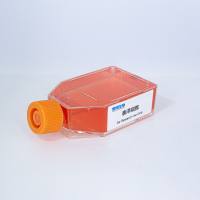泰泽(广州)生物科技有限公司
入驻年限:2 年
- 联系人:
泰泽
- 所在地区:
广东 广州市 天河区
- 业务范围:
抗体、ELISA 试剂盒、技术服务、试剂、细胞库 / 细胞培养
- 经营模式:
科研机构 生产厂商 代理商
推荐产品
公司新闻/正文
【细胞小讲堂】DU-145全面剖析:特点、应用、培养方法与研究进展
人阅读 发布时间:2024-03-29 17:21
DU-145是一种广泛应用于生物医学研究的人前列腺癌细胞系。这些细胞是研究前列腺癌生物学、药物测试和开发的宝贵模型。研究人员还利用DU-145细胞来研究前列腺癌发展的分子机制。
1.DU-145细胞的来源和一般特征
在使用细胞系之前,了解细胞系的来源和一般特征至关重要。
-
DU-145是一种人类前列腺癌细胞系,来源于一名患有转移性前列腺癌的高加索男子(69岁)的大脑。
-
与PC-3前列腺癌细胞一样,DU-145也表达雄激素受体。然而,当这些细胞接受雄激素配体处理时,它们不显示任何活性的雄激素受体响应基因。因此,DU145被认为是雄激素非依赖性细胞。
-
DU-145细胞呈上皮形态。
-
DU-145细胞是低三倍体,模态染色体数为64。它们表现出几条标记染色体,例如del(11)(q23),t(11q12q),16q+,del(1)(p32)和del(9)(p11)。
PC-3与DU145 两种前列腺癌细胞系都是雄激素受体非依赖性的。它们在致瘤和转移潜力方面有所不同。当注射到免疫功能低下的小鼠中时,PC-3细胞系形成高度转移的IV级腺癌。DU-145细胞系则发展为具有中度转移潜力的前列腺癌[1]。
2.培养条件
细胞来源:前列腺;转移灶
细胞形态:上皮细胞样
生长特性:贴壁生长 培养体系:EMEM (Eagle's Minimum Essential Medium) with medium supplements, i.e., 10% Fetal Bovine Serum (FBS), 2 mM L-Glutamine, 2.2 g/L NaHCO3, and EBSS.
推荐换液:2~3次/周
传代比例:1:3-1:4
倍增时间:~28-51 hours
保藏机构:ATCC;HTB-81;CCTCC;GDC0704
培养条件:气相:空气,95%;CO2,5%;温度:37℃
冻存条件:基础培养基+5%DMSO+40%FBS,液氮保存
生物安全等级:BSL1

3.DU-145细胞的优点和缺点
优点: ①致瘤性: DU-145是一种侵袭性致瘤性前列腺癌细胞系,具有中等转移潜力。用于开发免疫功能低下小鼠的DU145异种移植模型,以研究前列腺癌的生物学,发育以及体外和体内的生长。 ②雄激素受体独立性: DU-145前列腺癌细胞是雄激素受体非依赖性的。它们不依赖雄激素生长,当用雄激素处理时,在细胞和分子水平上没有反应。非常适合研究激素非依赖性前列腺癌机制。
缺点: ①体外模型: DU-145是转移性前列腺癌的体外细胞模型,因此可能无法完全代表原发性前列腺肿瘤的复杂性。此外,由于雄激素受体独立性等特定特征,它可能并不意味着所有前列腺癌类型和亚型。
4.DU-145细胞的研究应用
前列腺癌生物学:DU-145是研究前列腺癌生物学的相关模型。研究人员利用这些细胞来研究驱动癌症发展、进展和转移的分子机制。此外,还探索了与前列腺癌相关的遗传改变。2021 年进行的研究检查了 DU-145 细胞,以确定潜在的生物标志物,从而具有有效的诊断和治疗意义。该研究表明肌动蛋白γ1(ACTG1)是一种潜在的前列腺癌生物标志物,因为它通过MAPK / ERK途径激活促进癌细胞增殖并调节转移[2]。
药物筛选和开发:DU-145前列腺癌细胞被广泛用于测试潜在抗癌药物的细胞毒性和功效。这有助于研究人员识别新药,了解耐药性和潜在的分子机制。2022 年进行的一项研究探讨了树脂混合物、蜂胶或蜂胶在前列腺癌细胞系 PC-3 和 DU-145 中的细胞毒性作用。该研究显示了这种天然物质在两种细胞系中的生长抑制作用,并提出了其抗癌潜力[3]。另一项研究于 2019 年进行,调查了天然化合物甜菜碱在 DU-145 前列腺癌细胞中的抗增殖作用。研究表明,甜菜碱通过提高DU-145细胞中氧化应激介导的细胞死亡和炎症来发挥抗增殖活性[4]。
5.关于DU-145细胞系的一些文献
The following are some research publications on the DU-145 cell line.
Concentration-dependent effects of zinc sulfate on DU-145 human prostate cancer cell line: oxidative, apoptotic, inflammatory, and morphological analyzes
This study in the Biological Trace Element Research, 2020, proposed that zinc sulfate (ZnSo(4)) exerts anti-proliferative effects in DU-145 cells via inducing apoptosis, morphological changes, oxidative damage, and inflammation.
Selective cytotoxic and anti-metastatic activity in DU-145 prostate cancer cells induced by Annona muricata L. bark extract and phytochemical, annonacin
This research article was published in BMC Complementary Medicine and Therapies in 2020. This study explored the cytotoxic and anti-metastatic potential of a plant, Annona muricata L. bark extract, and its bioactive annonacin in the DU-145 cell line.
LncRNA LOXL1‐AS1/miR‐let‐7a‐5p/EGFR‐related pathway regulates the doxorubicin resistance of prostate cancer DU‐145 cells
This publication in IUBMB Life (2019) proposed that long non-coding RNA LOXL1-AS1 interaction with miR-let-7a-5p and EGFR pathway regulate the doxorubicin resistance in DU-145 prostate cancer cells.
Down-regulation of DDR1 induces apoptosis and inhibits EMT through phosphorylation of Pyk2/MKK7 in DU-145 and Lncap-FGC prostate cancer cell lines
This article in Anti-Cancer Agents in Medicinal Chemistry (2020) stated that Discoidin Domain Receptor1 (DDR1) gene downregulation causes DU-145 cells death and inhibits epithelial to mesenchymal transition (EMT) via activating Pyk2/MKK7 pathway.
Casticin inhibits human prostate cancer DU 145 cell migration and invasion via Ras/Akt/NF‐κB signaling pathways
This study in the Journal of Food Biochemistry (2019) proposed that Casticin, a polymethoxyflavone, inhibits migration and invasion of DU-145 cells by regulating Ras/Akt/NF‐κB signalling.
6. Resources for DU-145 Cell line: Protocols, Videos, and More
Many online resources are available on the DU-145 prostate cancer cell line. Here this section will mention a few resources explaining the handling, maintenance, and transfection protocol for these cells:
-
DU-145 transfection: This video tutorial is a step-wise guide for learning the protocol for transfecting DU-145 cells.
The DU-145 cell culture protocol is mentioned here.
-
DU-145 subculturing: This link will help you learn the protocol for subculturing or sub-cultivating DU-145 cells.
-
DU-145 cells: This website contains plenty of useful information about the DU-145 cell line, including DU145 medium, protocol for subculturing, and handling proliferative and cryopreserved cultures.
因篇幅原因,欲了解更多DU145 详细信息,如:STR profile、Publications、Hierarchy、HLA typing、Cell line collections 等等。
请点击链接查看https://wiki.taizecell.cn/index.php?title=DU145
或扫码输入DU145进行查询

参考文献
-
Lima, A.R., et al., Discrimination between the human prostate normal and cancer cell exometabolome by GC-MS. Scientific reports, 2018. 8(1): p. 5539.
-
Xiao, L., et al., Silencing ACTG1 expression induces prostate cancer epithelial mesenchymal transition through MAPK/ERK signaling pathway. DNA and Cell Biology, 2021. 40(11): p. 1445-1455.
-
Gogacz, M., et al., Anticancer effects of propolis extracts obtained with the cold separation method on PC-3 and DU-145 prostate cancer cell lines. Molecules, 2022. 27(23): p. 8245.
-
Kar, F., et al., Betaine suppresses cell proliferation by increasing oxidative stress–mediated apoptosis and inflammation in DU-145 human prostate cancer cell line. Cell Stress and Chaperones, 2019. 24: p. 871-881.






